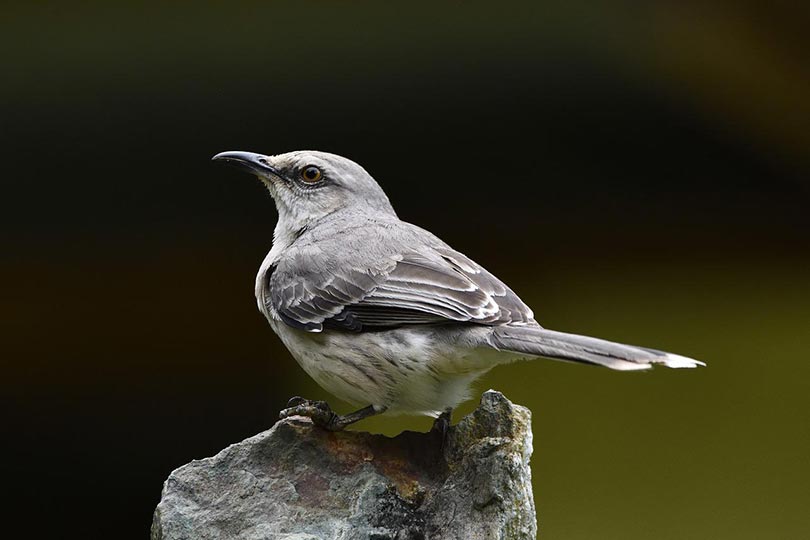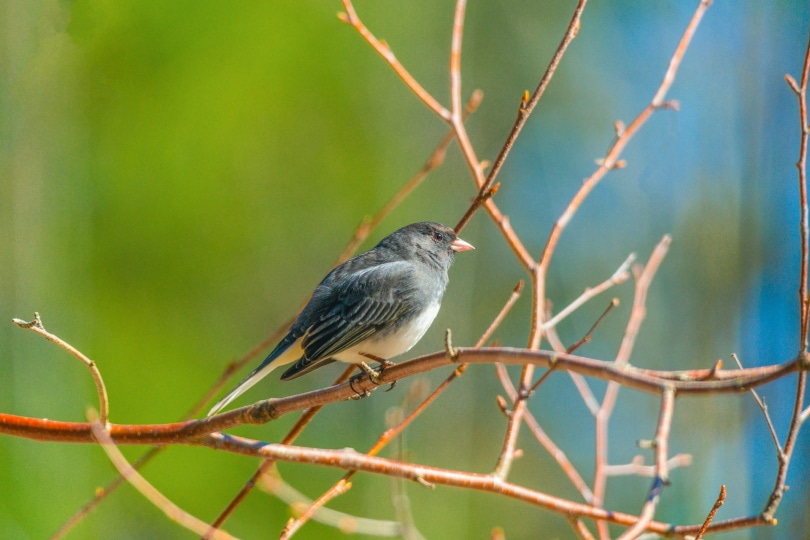Where Do Mockingbirds Nest? Nesting Habits Explained
Last Updated on

Mockingbirds are intriguing singers that love to visit backyards. These stunning birds are cheerful, and they have a lot of interesting habits. Some of their most important habits are related to nesting, so we want to explain this topic further.
Keep reading to learn where mockingbirds nest and how their nesting ritual looks.

The Nesting Habits of Mockingbirds

| Nesting Facts | |
| Clutch size | 2–6 eggs |
| Incubation period
|
12–13 days |
| Nesting period
|
12–13 days |
| Egg size
|
Around 1 inch high and 0.8 inches wide |
| Egg color | Pale blue or green with small spots |
Once Mockingbirds find their mate, they will remain together through spring and summer, while some Mockingbirds mate for life. Their breeding season typically begins in April and lasts until July, but that can extend for a month or so.
The males establish the breeding territory much earlier, around February, while the females without a mate remain in the wintering territory until they find a mate. Already formed couples might stay in the wintering territory until it’s time to build the nest.
Once the breeding season starts and an unmated female enters a territory of a breeding male, they will start the courtship process. The male Mockingbird pursues the female, who can choose whether to stay with the new mate or find her old one.
Mockingbirds are commonly monogamous; if a male fails to find a mate, it will leave the breeding region.

Mockingbird Nests
Once there’s a formed pair, the Mockingbirds will start building their nest. Both the female and male participate, but the male does most of the work. It takes 2 to 3 days to make a bulky, cup-shaped nest out of twigs, branches, and other available items, including
- Grass
- Leaves
- Moss
- Hair
- Cotton
- Plant stems
- Paper
They commonly choose shrubs and trees for the nesting spot, typically 1 to 3 feet above the ground, because that way, they can easily defend themselves from predators and possible dangers. Through the breeding season, Mockingbirds can build multiple nests, although most remain abandoned.
Mockingbird Incubation and Eggs
The female lays 2–6 bluish-green eggs with tiny spots. She will wait until all the eggs come out to start incubating. The incubation lasts between 12 and 13 days, and the female is the only one incubating the eggs.
During that period, the male is near, providing food to the female and defending the nesting spot from predators. The eggs will hatch after incubating, and the Mockingbird chicks will remain with their parents for another 12 to 13 days.
Mockingbird Young
Once the young hatch, both parents will look over them and provide them food for another 12 to 13 days. In the beginning, the young are blind and featherless, so they need full attention from their parents.
Throughout this period, the male will start teaching the hatchlings to fly while the female makes a new nest for their next brood. Once they are strong enough to fly on their own, baby Mockingbirds will leave the nest.
It’s not uncommon for Mockingbirds to have multiple broods, typically between two and four. The young leave after 2 weeks, and the pair goes away to make a new brood. Mockingbirds don’t like to reuse old nests, but if they like their current breeding territory, they might build a new one nearby.

Mockingbird Nesting Facts
Here are a couple of Mockingbird nesting facts you should remember:
- Mockingbirds are typically monogamous
- The female and male construct the nest together; the male does most of the work
- Mockingbirds don’t like to reuse old nests
- They have multiple broods in one season
- Both parents feed the hatchlings
Will Mockingbirds Use a Birdhouse To Nest?
Many people love to attract all kinds of birds to their backyards, including Mockingbirds. However, is it possible for Mockingbirds to use a birdhouse for nesting?
Mockingbirds thrive in the wilderness and have specific preferences for nesting, so there’s a chance they won’t like your birdhouse for their nesting spot. Commonly, they look for higher areas, so your birdhouse needs to be high enough to attract them.
Still, if you make the birdhouse look as natural as possible, you might be able to attract them to nest in your backyard. Try to put the birdhouse high up in a tree and provide enough food.

Summing Up
Mockingbirds like to nest in safe, secluded areas where their young will have protection from predators. Both parents will care for the hatchlings and remain with them until they learn to fly. Once the young become independent, Mockingbirds will build new nests and hatch new broods.
Featured Image Credit By: Hippo_Lytos, Pixabay
About the Author Visnja Radosavljevic
Visnja is a creative, adaptable content writer that covers various topics such as DIY, pets, home improvement, travel, gardening, and more. As a young mom and a college student, she didn’t have enough time to balance her personal and work life, so after multiple years of working a regular 9 to 5 job, she decided to pursue her passion and make a living out of it. She has been writing for a couple of years now, helping people to find valuable and interesting information online.
Related Articles:
10 Types of Hummingbirds in Arkansas (With Pictures)
8 Types of Hummingbirds in Nebraska (With Pictures)
5 Types of Hummingbirds in Idaho (With Pictures)
3 Types of Hummingbirds in Mississippi (With Pictures)
8 Types of Hummingbirds in Kansas (With Pictures)
5 Types of Hummingbirds in West Virginia (With Pictures)
5 Types of Hummingbirds in Ohio (With Pictures)
Where Do Nuthatches Nest? Nuthatch Nesting Habits Explained
